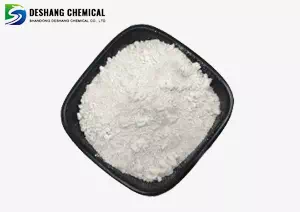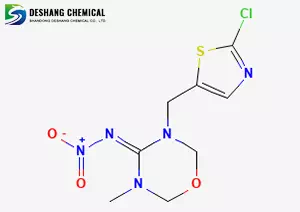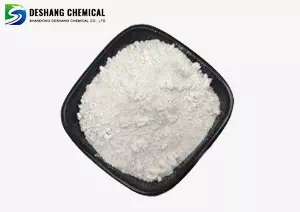All Categories



Thiamethoxam CAS 153719-23-4, Thiamethoxam, CAS 153719-23-4
Thiamethoxam, as an efficient systemic insecticide, plays a significant role in the integrated control of agricultural pests, especially in the management of resistant pests. When in use, strictly follow the safety interval period, avoid harming pollinating insects, and pay attention to residue compliance.
CAS : 153719-23-4
Formula : C8H10ClN5O3S
Mol. wt. : 291.71
EINECS : 428-650-4
| CAS | 153719-23-4 |
| Molecular formula | C8H10ClN5O3S |
| Molecular weight | 291.71 |
| EIENCS | 428-650-4 |
| Form | neat |
| Melting point | 139.1°C |
| boling point | 485.8±55.0 °C |
| Density | 1.71±0.1 g/cm3 |
| Solubility | DMSO: 250 mg/mL (857.02 mM) |
| PKA | 0.99±0.10(Predicted) |
| Color | / |
| Storage temp | / |
Thiamethoxam, as an efficient systemic insecticide, plays a significant role in the integrated control of agricultural pests, especially in the management of resistant pests. When in use, strictly follow the safety interval period, avoid harming pollinating insects, and pay attention to residue compliance.
Molecular formula and structure
Molecular formula: C₈H₁₀ClN₅O₃S
Molecular weight: 291.71 g/mol
Chemical name: 3 - (2 - chloro - 1, 3 - thiazole - 5 - methyl) - 5 - methyl - 1,3,5 - evil diazine - 4 - fork (nitrocellulose) amine
Appearance: White or off-white crystalline powder.
Physical properties
Melting point: 139.1℃
Water solubility: 4.1g /L (at 25℃), slightly soluble in water, readily soluble in organic solvents such as acetone (48g /L) and dichloromethane (110g /L).
Stability: Avoid storing in an environment below -10℃ or above 35℃, and do not mix with alkaline substances.
Applicable to crops and pests
| Crop type | Target of prevention and control | Usage method |
|---|---|---|
| Rice | Rice planthoppers, rice elephant beetles | Spray (1.6-3.2g/ mu) |
| Fruit trees (apples/pears) | Aphids, pear psyllids | Spray at a dilution of 5,000 to 10,000 times |
| Cotton | Cotton aphids, thrips | Spray at a rate of 13 to 26 grams per mu |
| Potato | Peach aphids, leaf beetles | Seed treatment (4-7.5g/kg) |
| For detailed dosage, please refer to the standards of each crop |
Application method
Foliar spray: Rapid control of adult insects (such as whiteflies in melons)
Soil root irrigation/treatment: Control of underground pests (nematodes, grubs)
Seed coating: Prevention of seedling pests (such as corn, soybeans, etc.)
Toxicity assessment
Low toxicity: Acute oral LD₅₀=1563 mg/kg in rats, no irritation to the skin and eyes, but long-term intake of food with excessive residues may be harmful to health.
Ecological risk: Highly toxic to bees ⚠️. Use should be avoided during the pollination period. It is slightly toxic to aquatic organisms.
Residue standard
ADI value: 0.08 mg/kg bw (GB 2763-2021), common food residue limits are 0.01 to 2 mg/kg (such as grains, fruits and vegetables).
* Prompt reply and 24 hours online, professional team to provide best price and high quality product.
* Sample testing support.
* Every batch of products will be tested to ensureits quality.
*The packing also can be according the customers` requirment.
*Any inquiries will be replied within 24 hours.
*we provide Commerical Invoice, Packing List, Bill of loading, COA , Health certificate and Origin certificate. If your markets have any special requirements, let us know.